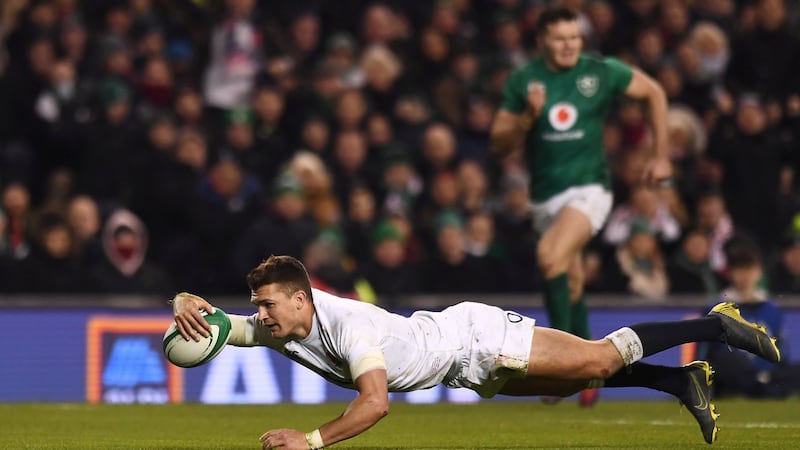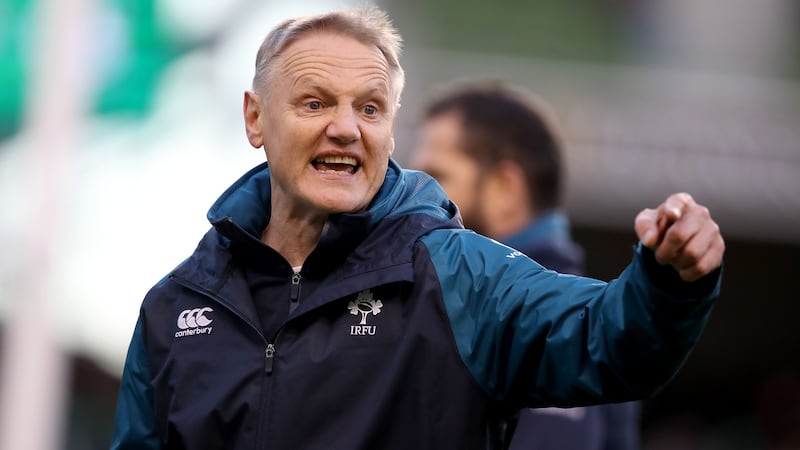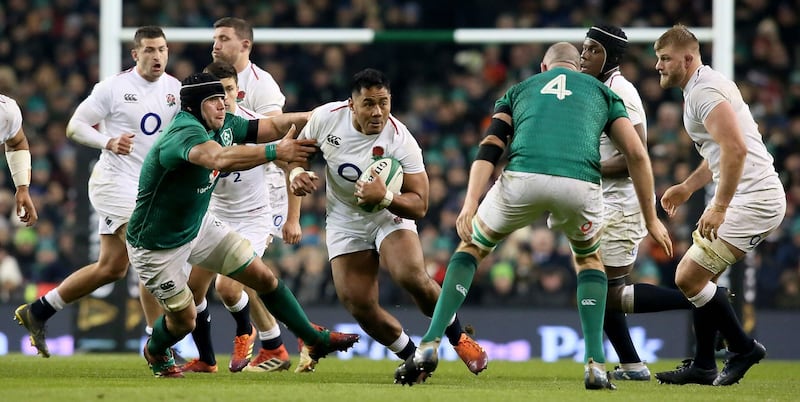We now know that Plan C is going to be needed.
At an event last week the signature performance of Joe Schmidt’s Ireland, so far, was discussed. Beating New Zealand gets mentioned everywhere I go, and understandably so. One question focused on the difference between how Ireland and the All Blacks attack.
Bob Casey was sitting beside me. My old Leinster team-mate is a sturdy six foot eight inches barefoot.
“Stand up Bob.”
I also got off my chair, turned to the audience and tapped my chest, “This is the size of an Irish rugby player,” before looking up, “and here is your average Kiwi rugby player.”
The All Blacks tend to score off Sonny Bill Williams or whoever entering contact, on their own terms, before freeing hands and passing on or over the gainline.
Momentous Irish tries – see Jacob Stockdale last November or March 2018 – happen when the point of attack is cleverly changed with distribution before a dominant tackle can occur.
The Gordon versus Bob comparison was jokingly used to prompt people past flawed comparisons to New Zealand (I’m as guilty as the next).
Irish rugby possesses an underage system that has us existing among the heavyweights of the international game but when it comes to body shapes and sizes, Irish players will never be truly comparable to All Blacks, Springboks or the English. That’s why players like CJ Stander and Bundee Aki were recruited.
One, it’s a numbers game. Two, we are a smaller breed. Happily so. I’m okay with who we are.
We will never be the giants of rugby. Nor should we ever want to be.
Rugby is basically the GAA in New Zealand and, like them, we love our Gaelic football and hurling so much that there will always be a club in every parish, in almost every nook and cranny on our island.
A highly motivated England, like New Zealand in November 2016, marched into Dublin with murderous intent
That’s what makes us uniquely Irish. We don’t want to alter that and we can tap into it for motivation.
Rugby is in a powerful place in Ireland but it’s not our national past-time so, every so often, like Saturday, there’ll be some vile medicine to swallow. A highly motivated England, like New Zealand in November 2016, marched into Dublin with murderous intent.
It hurts like hell to lose in such a convincing manner against this opposition but it can cleanse the soul. That’s what has been going on down Carton demesne way Sunday night and probably all Monday.
Honesty is the only currency in dark days. If players and coaches deal in it they can improve. If not, well, Eddie Jones had to clear out his backroom team after three defeats during last year's Six Nations.
Michael Cheika survived as Wallaby coach, despite losing nine Tests in 2018, but Stephen Larkham is off the ticket.
Schmidt does not operate in that manner. The group have been here before, they know what to do next. Their message will be clear.
Dented psyches and bruised bodies need healing, and fast, because as I write on Tuesday afternoon Schmidt’s staff will have done enough mollycoddling.
Those who can train will need to front up and be ready. Those who can't will not feature at Murrayfield – CJ Stander, Dev Toner and Garry Ringrose joining Tadhg Beirne and Iain Henderson on an injury list that will only expand.

It’s a ruthless business but individual scapegoating only undermines the overall plan. Now, fingers will have been pointed during the film review but nobody is responsible for the loss. Having to re-watch those collisions is punishment enough.
Anyway, that’s on players to sort out themselves. Each man knows how he fared in the face of English aggression. My use of Bob Casey’s huge frame is partially serious, but the Irish players are hardly small men. They know what happened and they know the defeat was down to the top six inches as much as it was a “man handling”.
Joe’s words.
Also, the coach has said what he wanted to say about the back fielders. The damage Keith Earls sustained from illegal Tom Curry and Maro Itoje hits meant Robbie Henshaw's first start at fullback in three years was handicapped by an injured winger struggling to cover ground. In the second half there were two young men either side of him. Ireland need options in every position, was the coach's message.
We failed to stop them cold. There wasn't a single turnover on their ball
Team selection this week will be fascinating.
The presumption from everyone tipping Ireland was that we would cope with England’s initial onslaught. Manu Tuilagi’s charge off a long lineout was their statement of intent. Ireland, uncharacteristically, soaked up rather than dominated those early collisions. We failed to stop them cold. There wasn’t a single turnover on their ball.
This group can recover. There will be a response against Scotland.
This team is not weak of body or mind.
I’ve written over and over about the team’s culture. Really, it only gets examined on weeks such as this.
Putting Peter O’Mahony in front of the media Monday lunchtime was smart. When the Munster captain tells you nobody is panicking you believe him. The team never bought into the hype.
That's not why they lost. Above all else, England stopped them on the gain line. That made Conor Murray and Johnny Sexton look as if they lacked ideas but everyone struggles when slow ball trickles from the ruck.

When this situation reoccurs, either during the Six Nations or in Japan, what do Ireland do?
When they took to the skies, via Murray’s boot, the officials deemed the line of England blockers to be legal.
Okay, now what?
The answers have already been embedded in the minds of Irish players. It could be little tip-off pass before contact or a punch play behind the first forward to avoid England gang tackling the “front door” ball carrier.
There is an argument that the on-field leaders didn't problem solve but England deserve enormous credit and not just up front. Elliot Daly, Henry Slade and Jonny May combined expertly, displaying lovely skills at pace, for three tries. Ireland will definitely feel they could have defended better but the momentum was against them as soon as Earls and Murray were caught out for the first try.
I've been talking up Slade since the warm-up match against France before the 2015 World Cup (same game that paved the way for Sam Burgess to be selected). Ever since that impressive performance, I've wondered why the England coaches, Stuart Lancaster and now Eddie Jones, haven't given him the 13 jersey on a permanent basis. Jonathan Joseph is a serious athlete but Slade, to Exeter's benefit on a weekly basis, has the essentials required to play Test rugby at centre.
Saturday proved it. Saturday also showed us the ideal England midfield. That’s their best team, clearly.
They exposed Irish flaws, in several areas, especially the physicality stakes.
The same Ireland team that steadily climbed to number two in the world with three Six Nations titles since 2014. Still, the Irish plot chart tends to be erratic, even under Schmidt, but little needs to change ahead of Scotland. Injury has intervened – Stander’s damaged face means the backrow balance requires a re-think – but England also suffered. They must battle on without Itoje.
The seeds of Plan C need planting if Ireland are to reach a World Cup semi-final. England did Schmidt a favour by showing exactly how the Springboks will go about winning a quarter-final against them.

Another route over or around the gainline must be found when the usually effective multi-phase, inch by inch approach (Plan A) and aerial tactics, as directed by Murray (Plan B) are stymied.
George Kruis, Mako and Billy Vunipola were lining up ball carriers and smashing them backwards. These huge men in white will be replaced by dark green or black jerseys later this year. Wales proved in Paris they will happily defend a clueless attack that runs straight at them.
Every team that Ireland faces will now attempt to replicate the English template from the Aviva (like, the line of blockers when Murray box kicks). When it really matters, Ireland must dig deep and execute the game plan they wished they had played against England.
Is there any other coach you’d prefer to have in this situation?
Scotland will present new problems. The Slam and silverware, Triple Crown and championship, are beyond Ireland’s reach so the focus can be simplified. Whoever is fit to play must rediscover the physical standards the team expects of themselves.
The coach and play-makers will figure out the rest.














